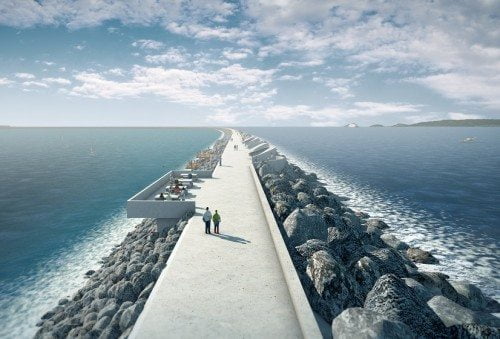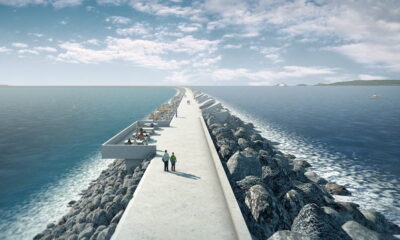

Energy
Government Launches Independent UK Tidal Lagoons Review
The government acknowledges progress has been made to understand tidal lagoon technology, but says more work needs to be done to determine whether they present value for money. They have commissioned a review of the technology to improve their understanding of how tidal lagoons could contribute to the future of the UK’s energy mix in the most cost effective way.
The review will commence this spring and it will help establish an evidence base to ensure all decisions made regarding tidal lagoon energy are in the best interest of the UK.
Tidal Lagoon Power, the proposed developers of Swansea Bay Tidal Lagoon, and other industry stakeholders will take part in the review while discussions about Swansea Bay Tidal Lagoon continue.
Energy Minister Lord Bourne commented: “Tidal Lagoons on this scale are an exciting, but as yet an untested technology. I want to better understand whether tidal lagoons can be cost effective, and what their impact on bills will be – both today and in the longer term.
“This review will help give us that clarity so we can determine what role tidal lagoons could have as part of our plans to provide secure, clean and affordable energy for families and businesses across the country.”
Commenting on today’s announcement Kepler Energy’s Peter Dixon (Executive Chairman) said: “The opportunity that tidal stream energy offers the UK must not be overshadowed by the hiatus surrounding Tidal Lagoons and Swansea Bay. Kepler Energy is working hard to bring forward plans for a tidal energy fence that will be located in the Bristol Channel and we have shared our outline plans with a range of stakeholders including the Department of Energy & Climate Change, the Welsh Government, the Crown Estate and the Treasury.
“Our tidal energy technology will use the very latest carbon composite technology, and can be deployed in shallower, lower velocity tidal waters around the UK coastline and also in overseas waters, in countries such as China, Korea, Japan and India. Subject to planning and financing, the Bristol Channel tidal fence, which is likely to be located in the Aberthaw to Minehead stretch of water, could be operational by 2025.”
“Kepler Energy’s technology is regarded as environmentally benign and would be subject to a rigorous environmental impact assessment during the planning process to ensure that it carries no significant risk to marine life and other users of the sea.
Dixon added: “Our Bristol Channel tidal fence has the potential to mobilise the carbon composite industry in the UK, as well as to create new and skilled jobs in Wales and the West Country.
“The opportunity that tidal stream energy offers the UK is very significant. Our tidal stream technology at scale can quickly be cost competitive with nuclear generation and offshore wind, and can be deployed quickly and extensively in UK and overseas waters.”
Mark Shorrock, chief executive of Swansea Bay Tidal Lagoon, said: “This is a huge step from the UK Government and a clear signal that it sees potential advantage for the UK energy consumer in very long-dated tidal energy infrastructure assets.
“There is vast potential for tidal lagoon power to provide cheap long-term renewable energy at scale and to be taken formally into national policy.
“We welcome the opportunity to put the case for a major programme of cost-effective power. This is a home-grown source of power, the natural way to power our nation. We have built a supply chain which puts UK companies at the forefront of a new world-leading technology.”
Continuing, Mark Shorrock expressed concern about the continuing delay in considering the demonstration first-of-a-kind tidal lagoon for the UK. He said: “It is imperative that we conclude our structuring and commercial negotiation with Government within the next 6 weeks. This is entirely possible; the review should not impact the finalisation of our commercial discussions. To unlock the potential of tidal lagoon power, we need investment in a demonstration project that will grow the supply chain and build investor confidence that an exceptionally long term project can go forward in today’s UK electricity market.
“Swansea Bay Tidal Lagoon is an appropriately small pilot project that gives rise to large scale projects. Investing in this project could add as little as 10p to householder’s bills. The first large scale lagoon to employ its blueprint could take £5 off householder’s bills
“The project planned for Swansea Bay is ready to go now. We have built a team, secured planning permission, secured equity sponsors, prepared a delivery team and a supply chain. We have received overwhelming support for this project locally, nationally and internationally. If tidal lagoon power at scale is to be a real option for the longer term, we need to start work on Swansea Bay Tidal Lagoon now. Otherwise the opportunity will be lost and the review will be all for nothing.
“We want to give birth to a tidal range industry. We want to return steel workers into jobs. We want to make our own turbines and generators here in the UK, we want to bestow a legacy on Great Britain from Wales of 120 year life power. But none of this will be possible if we don’t start now.
“A welcome review should not be. There is a serious and growing gap of electricity generation capacity. We need 16 new large scale power stations. The cheapest new power stations will be tidal lagoons, roof-top solar power and gas fired power stations. We need all three and quickly. And when the nuclear stations are ready, we will probably need them too, but their timescales are more uncertain.
“This country either started or scaled many of the world’s industries, including many of the world’s energy industries. Energy in the UK has become a completely regulated market where all operators and technology forms – from fossil fuel, to nuclear, to renewable – depend on direct or indirect subsidy. All non-hydro low carbon energies – solar, biomass, wind, and especially nuclear – have been conformed to favour foreign providers of the technology. We lose jobs, we lose time. Importantly, we also have lost baseload power.
“The tidal lagoon fleet breaks this unfavourable tradition. We will capitalise on a natural advantage. With speed we will deliver baseload power at a nuclear scale and a lower cost. Today’s review will ensure that we are able to consolidate this understanding in the market.
“We have made a value-for-money proposition to Government. There is no reason not to press on with Swansea Bay Tidal Lagoon negotiations.
“Recognising the extremely long asset life of a tidal lagoon enables the overall financing costs to be significantly reduced.
“The world-first tidal lagoon that carries on its shoulders the launch of a global industry now requires a lower level of subsidy support than any offshore wind farm ever built in the UK.
“We have proposed an equivalent CfD strike price for the 320MW Swansea Bay Tidal Lagoon below that of offshore wind. Our structure has a subsidy that reduces over time, meaning that for around half of the proposed 90-year contract, the lagoon pays money to Government.
“By linking Swansea Bay Tidal Lagoon to the successful delivery of a second, fullscale lagoon, this approach further reduces the required and proposed equivalent CfD strike price of Swansea Bay to under £100/MWh, comparable to the Hinkley C nuclear power station.
“Application of these bespoke support structures to the Cardiff Tidal Lagoon, a 2,700MW capacity project, the equivalent CfD strike price requirement is £68.30/MWh. It is excellent to have an independent review to substantiate how tidal lagoons can bring down electricity bills immediately after demonstration stage while providing Victorian-style infrastructure legacy.
“Our company’s vision is to harness the tides to generate our power, and to establish a new global industry in the UK. Today’s review launch confirms a strong interest from Government in this vision.
“We look forward to continuing to work with Government on the delivery of this vision, including on the most efficient financial support structures for tidal lagoons. But we will be pushing for Government support to demonstrate the potential of tidal lagoon power by giving the go-ahead for the Swansea Bay project, thereby avoiding the still birth of a game-changer for UK energy and UK industry.”
The review will consider:
– An assessment of whether, and in what circumstances, tidal lagoons could play a cost effective role as part of the UK energy mix;
– The potential scale of opportunity in the UK and internationally, including supply chain opportunities;
– A range of possible structures for financing tidal lagoons;
– Different sizes of projects as the first of a kind;
– Whether a competitive framework could be put in place for the delivery of tidal lagoon projects.
This review will take place in consultation with the relevant Government departments – in particular DECC and HMT for financial aspects.


 Environment10 months ago
Environment10 months agoAre Polymer Banknotes: an Eco-Friendly Trend or a Groundswell?

 Environment11 months ago
Environment11 months agoEco-Friendly Home Improvements: Top 7 Upgrades for 2025

 Features9 months ago
Features9 months agoEco-Friendly Cryptocurrencies: Sustainable Investment Choices

 Features10 months ago
Features10 months agoEco-Friendly Crypto Traders Must Find the Right Exchange





























